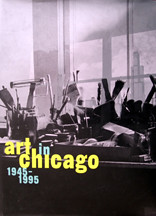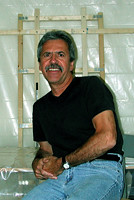Art in Chicago
Art in Chicago: 1945 – 1995
Daniel Ramirez
Note: This is the Ramirez catalog essay for "Art in Chicago: 1945 – 1995" at Chicago's Museum of Contemporary Art inaugural exhibit of its new building, 1996
Born 1941 Chicago native Daniel Ramirez, also known since the 1980s by the name Daniel Smajo-Ramirez, which. honors his mother, has been one of the city's leading champions of abstract painting, since the mid-1970s. Along with artists as disparate as Miyoko Ito, Frank Piatek, and William Conger, Ramirez upholds a tradition of nonrepresentational painting that has flourished in Chicago alongside its better-known figurative counterpart since the 1950s. After a short stint as a truck driver hauling steel at a mill, Ramirez at age thirty-two enrolled at U IC to study art. Immediately after receiving his BA in painting in 1975, he pursued an M FA from the University of Chicago (1975-77). He emerged from graduate school with a taut visual language of severely geometric forms, a Minimalist treatment of color, and a compositional tendency toward Chicago Bauhaus Constructivism.
In his paintings Ramirez is always careful to maintain an equilibrium of color, line, shape, and tone. As his work evolved, black, blue, green, and orange modulated lines began to divide and define the compositions, serving both as borders that enclose the larger shapes within the painting and as narrow, tapering demarcations that separate the canvas into vertical rectangles. By 1976 the paintings had increased dramatically from three feet square to eight-by-twelve feet. Ramirez also began to combine canvases, adding triangular sections to create trapezoidal paintings as well as graduated graphite panels to his painted canvases.
Contrary to his aloof and cerebral aesthetic, however, Ramirez's paintings reflect his personal responses to the world and express extreme emotions such as anguish, tragedy, or spiritual rapture. For Ramirez, form, line, and color convey a visual harmony in their relationships, but they must also reveal the experiences of the soul. He often takes his inspiration from music or philosophy. His paintings from the late 1970s entitled TL-P are a direct response to the writings in Austrian philosopher Ludwig Wittgenstein's Tractatus Logico-Philosophicus. A 1980 series of etchings is a response to the music of French composer Oilvier Messiaen: the rich purples are meant to reveal the extent of the artist's soul and to evoke religious convictions. Ramirez's most recent works, completed since he relocated to Wisconsin In 1988, combine his characteristic formalism with expressively crafted sculptural elements.
Ramirez taught at UIC from 1978 until 1988; he now teaches at the University of Wisconsin, Madison. For over two decades his work has been widely exhibited, including a number of one-person shows at Roy Boyd Gallery in both Chicago and Los Angeles. Chicago's Renaissance Society held a one-person exhibition of Ramirez's paintings in 1979 and AIC featured a suite of Ramirez's intaglio prints in "Twenty Contemplations on the Infant Jesus: An Homage to Oilvier Messiaen" in 1981. Ramirez's group exhibitions include "Recent Masterpieces of Chicago Art" at The Chicago Public Library Cultural Center (1977); C & V show at AIC (1978); "Chicago: Some Other Traditions," Madison Art Center, Wisconsin (1983); Abstract/Symbol/ Image: A Revision" at H PAC (1984); " Adivina! Chicago Latino Expressions" at the Mexican Fine Arts Center Museum, Chicago, and Museo de Arte Moderna, Mexico City (1988); and "Post-Minimalism and the Spiritual: Four Chicago Artists" at The Museum of Contemporary Religious Art, St. Louis University [1994). EKW
Return to Ramirez@Luz Web Site



0 Comments:
Post a Comment
<< Home